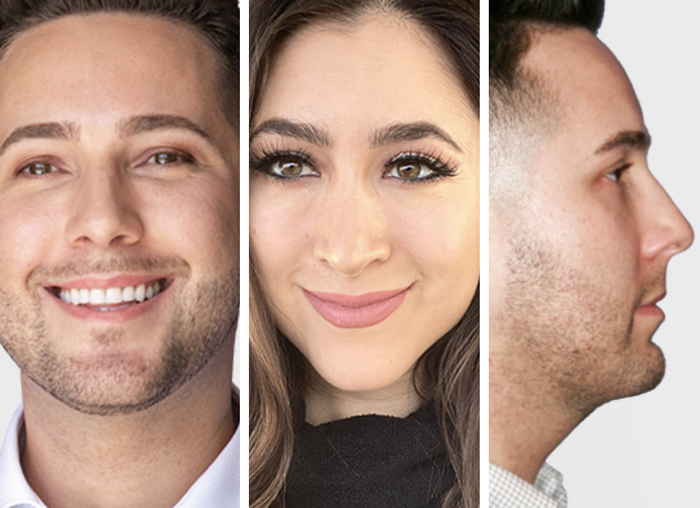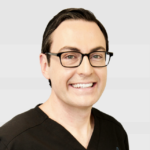As we age, the youthful, roundness of our cheeks flattens. Volume loss in this area is related to changes in the fatty tissues of the lower eyelid and cheek. In addition, gravity exerts a constant effect on the facial soft tissues, eventually dragging down the remaining cheek fat. The overall effect is a transition from a heart-shaped face of youth to a more pyramid-shaped face of middle age.
Many patients seek a change to the shape or volume of their lower eyelid and upper cheek area (also known as the zygoma and malar fat pad), alone or in combination with other aesthetic procedures. In most cases, the desired procedure is cheek augmentation (enlargement), which is often performed by placement of facial implants or fat grafting. Some patients, however, do not have the time or the desire to undergo a surgical procedure. For these patients, a great alternative is non-surgical cheek augmentation. Making the cheek fuller or giving it more shape and definition can be achieved with soft tissue fillers, such as Radiesse®, Voluma®, or Perlane®. This treatment is done in a single session in the comfort of our office. In addition, patients who have a deep depression or hollowness in the area just below the eyes (sometimes called the “tear trough” region) can also benefit from fillers placed here. Dr. Ransom uses micro-cannulas to reduce bruising and to make the injections in the sensitive tissues around the eyes more comfortable. Fillers used in this area are generally the thinner HAs, such as Restylane® or Belotero®.
Explore our
Patient Gallery
*Actual patients in photos

Dr. Ransom performs non-surgical cheek augmentation using two filler materials. The most common is Radiesse®, which is made of biocompatible calcium hydroxyapatite – a natural component of bone. This filler is relatively firm and is placed deep along the bone of the upper cheek. Radiesse® lasts between 12 and 18 months in this area for most patients. Another great option is Voluma®, the newest of the soft tissue fillers. Voluma® is made from highly cross-linked hyaluronic acid (HA), another naturally-occurring component of cartilage and connective tissue. Voluma® lasts longer than any other HA filler – up to 2 years! Finally, for patients who are just trying out cheek enhancement, shorter-lasting HA fillers are available. This would include Perlane®, which lasts between 6 and 12 months, depending on the individual patient’s unique facial structure and metabolism.
As with any injectable treatment, Dr. Ransom strives to provide the most comfortable experience possible. This includes the use of topical numbing creams, including numbing medicine mixed in with all types of injectable fillers, and providing icepacks after treatment.
Who is a candidate?
Anyone who desires increased projection or fullness in the upper cheek area may be a candidate for non-surgical cheek augmentation. Cheek augmentation may be performed as a stand-alone procedure or combined with other aesthetic treatments such as filler injections to the lower eyelid hollows. The key to any facial enhancement is identifying your aesthetic goals and the most appropriate and comfortable way to achieve them – while still looking natural. Dr. Ransom will work closely with you throughout this process.
Frequently Asked Questions
Please note that all patients are different and individual healing times and results may vary. The statements regarding procedures and recovery made here are general rules.
Soft tissue fillers are slowly broken down by the body over time. The duration of effect is dependent on the type of filler used, and, for HA fillers, the degree of crosslinking in the material. Dr. Ransom prefers to use longer-lasting and thicker fillers for non-surgical cheek augmentation. This gives a more reliable effect and is safe because the injections are placed deeply along the bone.
This depends on the type of filler used. HA fillers like Voluma® and Perlane® can be dissolved with small doses of an enzyme called hyaluronidase. For Raidesse®, the body slowly dissolves the filler material over time. There is not an enzyme to dissolve this product, but other techniques can be used to speed up the process.
If you have undergone a non-surgical cheek augmentation and like the results, but don’t want to have repeated treatments, there are more permanent options. The most common choice would be placement of cheek implants (see our dedicated procedure page). These are made of a silicone-based plastic (Silastic) come in a variety of shapes and sizes, with a full range to fit your needs. Placement involves a short surgical procedure with minimal downtime. For patients who do not wish to have implants, fat grafting is a great option. In this procedure, fat cells are taken from the abdomen (around the belly button) and then injected into the upper cheek and eyelid area. This gives a natural fullness to the area and helps restore the youthful, rounded cheeks.
Dr. Evan Ransom is an Ivy League-educated and Ivy League trained Facial Plastic and Reconstructive Surgeon. He is a Double Board Certified Head and Neck Surgeon and Facial Plastic and Reconstructive Surgery and fellowship-trained in facial plastic, reconstructive, and laser surgery. His practice is in the San Francisco Bay Area, serving patients from San Francisco, Oakland, Marin County, Palo Alto, Silicon Valley, Walnut Creek, the East Bay, and all over Northern California.
 (415) 550-1077
(415) 550-1077 San Francisco
San Francisco




